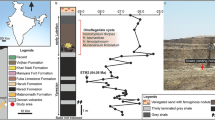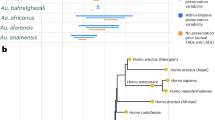Abstract
The Madtsoiidae were medium sized to gigantic snakes with a fossil record extending from the mid-Cretaceous to the Pleistocene, and spanning Europe, Africa, Madagascar, South America and Australia1,2,3. This widely distributed group survived for about 90 million years (70% of known ophidian history), and potentially provides important insights into the origin and early evolution of snakes. However, madtsoiids are known mostly from their vertebrae, and their skull morphology and phylogenetic affinities have been enigmatic. Here we report new Australian material of Wonambi, one of the last-surviving madtsoiids4,5,6, that allows the first detailed assessment of madtsoiid cranial anatomy and relationships. Despite its recent age, which could have overlapped with human history in Australia, Wonambi is one of the most primitive snakes known—as basal as the Cretaceous forms Pachyrhachis7 and Dinilysia8. None of these three primitive snake lineages shows features associated with burrowing, nor do any of the nearest lizard relatives of snakes (varanoids). These phylogenetic conclusions contradict the widely held ‘subterranean’ theory of snake origins9,10,11,12, and instead imply that burrowing snakes (scolecophidians and anilioids) acquired their fossorial adaptations after the evolution of the snake body form and jaw apparatus in a large aquatic or (surface-active) terrestrial ancestor.
This is a preview of subscription content, access via your institution
Access options
Subscribe to this journal
Receive 51 print issues and online access
$199.00 per year
only $3.90 per issue
Buy this article
- Purchase on Springer Link
- Instant access to full article PDF
Prices may be subject to local taxes which are calculated during checkout



Similar content being viewed by others
References
Rage, J. C. Handbuch der Paläoherpetologie. Teil 11. Serpentes (Gustav Fischer, Stuttgart, 1984).
McDowell, S. B. in Snakes: Ecology and Evolutionary Biology (eds Seigel, R. A., Collins, J. T. C. & Novak, S. S.) 1–50 (Macmillan, New York, 1987).
Rage, J. C. Fossil snakes from the Paleocene of São José de Itaboraí, Brazil. Part I. Madtsoiidae, Aniliidae. Palaeovertebrata 27, 109–144 (1998).
Smith, M. J. Small fossil vertebrates from Victoria Cave, Naracoorte, South Australia. IV. Reptiles. Trans. R. Soc. S. Aust. 100, 39–51 (1976).
Barrie, D. J. Skull elements and associated remains of the Pleistocene boid snake Wonambi naracoortensis. Mem. Qd Mus. 28, 139 –151 (1990).
Scanlon, J. D. First records from Wellington Caves, New South Wales, of the extinct madtsoiid snake Wonambi naracoortensis Smith, 1976. Proc. Linn. Soc. NSW 115, 233–238 ( 1995).
Lee, M. S. Y. & Caldwell, M. W. Anatomy and relationships of Pachyrhachis problematicus, a primitive snake with hindlimbs. Phil. Trans. R. Soc. Lond. B 353, 1521– 1552 (1998).
Estes, R., Frazzetta, T. H. & Williams, E. E. Studies on the fossil snake Dinilysia patagonica Woodward: Part 1. Cranial morphology. Bull. Mus. Comp. Zool. Harv. 140, 25–74 ( 1970).
Walls, G. L. Ophthalmological implications for the early history of snakes. Copeia 1940, 1–8 ( 1940).
Bellairs, A. d'A. & Underwood, G. The origin of snakes. Biol. Rev. 26, 193– 237 (1951).
Underwood, G. A Contribution to the Classification of Snakes (British Museum (Natural History), London, 1967).
Rieppel, O. A review of the origin of snakes. Evol. Biol. 22, 37–130 (1988).
Archer, M., Hand, S. J., Godthelp, H. & Creaser, P. in Actes du Congrès Biochrom '97 (eds. Aguilar, J.-P., Legendre, S. & Michaux, J.) 131–152 (École Pratique des Hautes Études Institute de Montpelier, Montpelier, 1997).
Scanlon, J. D. Nanowana gen. nov., small madtsoiid snakes from the Miocene of Riversleigh: sympatric species with divergently specialised dentition. Mem. Qd Mus. 41, 393–412 ( 1997).
LaDuke, T. C. The fossil snakes of Pit 91, Rancho La Brea, California. Nat. Hist. Mus. LA County Contrib. Sci. 424, 1– 28 (1991).
Frazzetta, T. H. Studies on the fossil snake Dinilysia patagonica Woodward. II. Jaw machinery in the earliest snakes. Forma et Functio 3, 205–221 (1970).
Cundall, D. Feeding behaviour in Cylindrophis and its bearing on the evolution of alethinophidian snakes. J. Zool. 237, 353–376 (1995).
Lee, M. S. Y. Convergent evolution and character correlation in burrowing reptiles: towards a resolution of squamate phylogeny. Biol. J. Linn. Soc. 65, 369–453 (1998).
Underwood, G. in Morphology and Biology of Reptiles (eds Bellairs, A. d'A. & Cox, C. B.) 151–175 (Academic, London, 1976).
Woodward, A. S. On some extinct reptiles from Patagonia, of the genera Miolania, Dinilysia, and Genyodectes. Proc. Zool. Soc. Lond. 1901, 169–184 (1901).
Zaher, H. The phylogenetic position of Pachyrhachis within snakes (Squamata, Lepidosauria). J. Vert. Paleontol. 18, 1 –3 (1998).
Kluge, A. G. Boine snake phylogeny and research cycles. Misc. Publ. Mus. Zool. Univ. Michigan 178, 1–58 (1991).
Cundall, D., Wallach, V. & Rossman, D. S. The systematic relationships of the snake genus Anomochilus. Zool. J. Linn. Soc. 109, 275–299 (1993).
Heise, P. J., Maxson, L. R., Dowling, H. G. & Hedges, S. B. Higher-level snake phylogeny inferred from mitochondrial DNA sequences of 12S rRNA and 16S rRNA genes. Mol. Biol. Evol. 12, 259–265 (1995).
Hecht, M. K. The vertebral morphology of the Cretaceous snake, Dinilysia patagonica Woodward. N. Jb. Geol. Paläont. Mh. 1982, 523–532 (1982).
Nopcsa, F. Eidolosaurus und Pachyophis. Zwei neue Neocom-Reptilien. Palaeontographica 65, 99–154 (1923).
Cope, E. D. On the reptilian orders Pythonomorpha and Streptosauria. Proc. Boston Soc. Nat. Hist. 12, 250–266 (1869).
Janensch, W. Über Archaeophis proavus Mass., eine Schlange aus dem Eocän des Monte Bolca. Beitr. z. Paläont. Geol. Österreich-Ungarns 19, 1–33 (1906 ).
Wallach, V. & Rainer, G. Visceral anatomy of the Malaysian snake genus Xenophidion, including a cladistic analysis and allocation to a new family. Amphibia–Reptilia 19, 385–404 (1998).
Swofford, D. L. PAUP* Version 4—Phylogenetic Analysis Using Parsimony (*and Other Methods). Computer program and documentation. (Sinauer, Sunderland, Massachusetts, 1999).
Acknowledgements
We thank D. J. Barrie, M. Archer, R. E. Molnar, N. Pledge and R. T. Wells for access to materials, and V. Wallach, G. Underwood, J.-C. Rage, D. J. Barrie, S. E. Evans, H. W. Greene, D. Cundall, M. W. Caldwell and A. G. Kluge for discussion. This research was supported by Australian Research Council grants to M.L. and J.S. Work at Riversleigh was supported by the Australian Research Council and University of New South Wales (to M. Archer), and work at Naracoorte by Flinders University, the South Australian Museum, L. and G. Henschke, the Barrie family and numerous volunteers.
Author information
Authors and Affiliations
Corresponding author
Supplementary information
Rights and permissions
About this article
Cite this article
Scanlon, J., Lee, M. The Pleistocene serpent Wonambi and the early evolution of snakes . Nature 403, 416–420 (2000). https://doi.org/10.1038/35000188
Received:
Accepted:
Issue Date:
DOI: https://doi.org/10.1038/35000188
This article is cited by
-
The evolution of the axial skeleton intercentrum system in snakes revealed by new data from the Cretaceous snakes Dinilysia and Najash
Scientific Reports (2019)
-
The ecological origins of snakes as revealed by skull evolution
Nature Communications (2018)
-
The oldest known snakes from the Middle Jurassic-Lower Cretaceous provide insights on snake evolution
Nature Communications (2015)
-
A phylogeny and revised classification of Squamata, including 4161 species of lizards and snakes
BMC Evolutionary Biology (2013)
-
A transitional snake from the Late Cretaceous period of North America
Nature (2012)
Comments
By submitting a comment you agree to abide by our Terms and Community Guidelines. If you find something abusive or that does not comply with our terms or guidelines please flag it as inappropriate.



